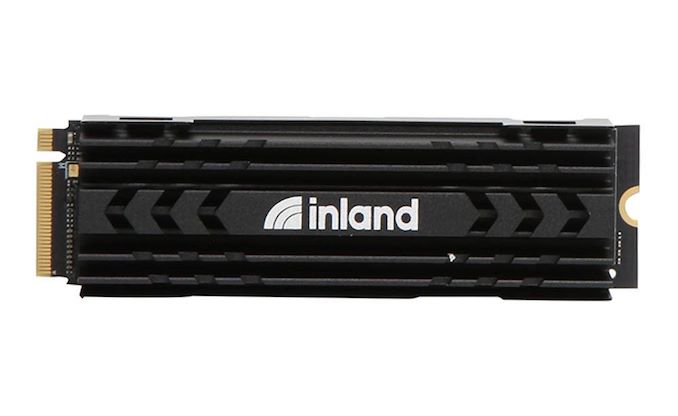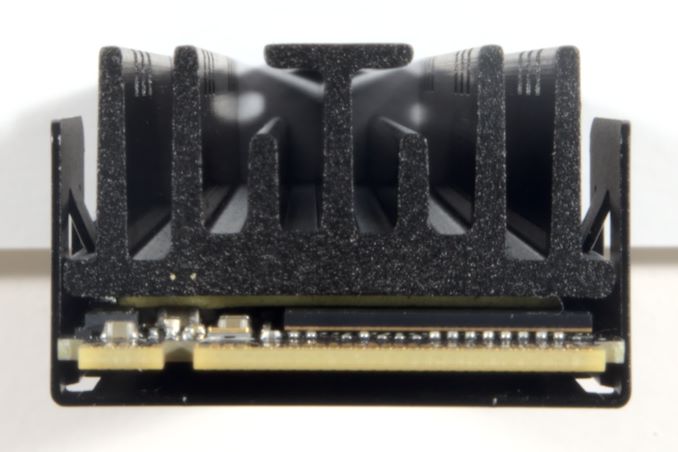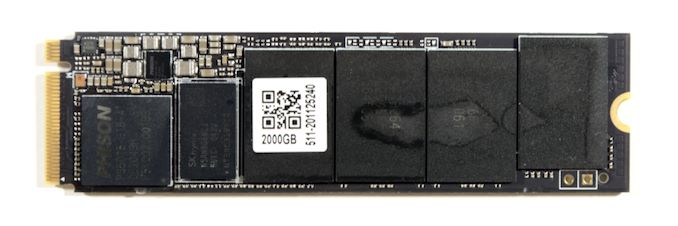The Inland Performance Plus 2TB SSD Review: Phison's E18 NVMe Controller Tested
by Billy Tallis on May 13, 2021 8:00 AM EST
Phison kicked off the transition to PCIe 4.0 for storage in 2019, and dominated the high-end SSD market for over a year with the only available PCIe 4.0 solution. There are now several competing PCIe 4.0 NVMe SSDs and controllers that handily outperform the Phison E16, but Phison has stayed competitive by bringing out a second-generation PCIe 4.0 controller, the E18. Today we're looking at one of many drives built around that controller: the Inland Performance Plus 2TB.
The Inland brand is owned by the parent company of American retailer Micro Center. Most or all Inland-branded SSDs are simply Phison reference designs with little or no customization beyond cosmetics. Inland SSDs are frequently great value options—especially for Micro Center's in-store only deals, but even their online prices tend to be very competitive. Part of the discount comes from their tendency toward shorter warranty periods: the Inland Performance Plus has only a three year warranty despite being a high-end flagship model. Fortunately, the total write endurance rating is the same as competing drives that carry five year warranties, and the SSD hardware itself is identical to other brands selling the same SSD reference design under different heatsinks and labels.
As part of the second wave of PCIe 4.0 SSD controllers, the Phison E18 aims to use substantially all of the performance available from the PCIe 4.0 x4 interface: sequential transfers up to around 7.4 GB/s and random IO up to about 1M IOPS. Hitting that level of performance while staying within M.2 power delivery and thermal dissipation limits required migrating to 12nm FinFET fabrication from the cheaper 28nm widely used by PCIe 3.0 SSD controllers and by the Phison E16. But even so, the Phison E18 can draw more power than the E16 controller because the increase in performance is so large. Competition for the Phison E18 includes in-house controllers used in the latest flagship consumer SSDs from Samsung and Western Digital, newcomer Innogrit's IG5236 Rainier controller, and Silicon Motion's upcoming SM2264 controller.
| Phison High-End NVMe SSD Controller Comparsion | |||||||
| E12 | E16 | E18 | |||||
| Manufacturing Process | 28 nm | 12 nm | |||||
| CPU Cores | 2x Cortex R5 | 3x Cortex R5 | |||||
| Error Correction | 3rd Gen LDPC | 4th Gen LDPC | |||||
| DRAM | DDR3/4 | DDR4 | DDR4, LPDDR4 | ||||
| Host Interface | PCIe 3.0 x4 | PCIe 4.0 x4 | |||||
| NVMe Version | NVMe 1.3 | NVMe 1.4 | |||||
| NAND Channels, Interface Speed |
8 ch, 667 MT/s |
8 ch, 800 MT/s |
8 ch, 1600 MT/s |
||||
| Max Capacity | 16 TB | 16 TB | 16 TB | ||||
| Sequential Read | 3.4 GB/s | 5.0 GB/s | 7.4 GB/s | ||||
| Sequential Write | 3.2 GB/s | 4.4 GB/s | 7.0 GB/s | ||||
| 4KB Random Read IOPS | 700k | 750k | 1M IOPS | ||||
| 4KB Random Write IOPS | 600k | 750k | 1M IOPS | ||||
| Controller Power | 2.1 W | 2.6 W | 3.0 W | ||||
| Sampling | Q2 2018 | Q1 2019 | Q1 2020 | ||||
| Retail SSD Availability | Q4 2018 | Q3 2019 | Q4 2020 | ||||
The Inland Performance Plus does not quite hit the theoretical limits of the Phison E18 controller. The 1TB model is clearly handicapped on some performance metrics compared to the 2TB model, but even the latter is only rated for 7GB/s sequential reads and 650-700k IOPS instead of 7.4GB/s and 1M IOPS. This mostly comes down to the Inland Performance Plus and other current E18 drives using 96L TLC NAND with 1200MT/s IO between the NAND and the controller, while the E18 can support up to 1600MT/s IO. A new round of E18-based products will start hitting the market soon using Micron 176L TLC that operates with the higher IO speed and should bring some other performance and efficiency improvements. We expect some of these new drives to be announced at Computex next month.
| Inland Performance Plus SSD Specifications |
||||
| Capacity | 1 TB | 2 TB | ||
| Form Factor | M.2 2280 PCIe 4.0 x4 | |||
| Controller | Phison E18 | |||
| NAND Flash | Micron 96L 3D TLC | |||
| Sequential Read (GB/s) | 7.0 | 7.0 | ||
| Sequential Write (GB/s) | 5.5 | 6.85 | ||
| Random Read IOPS (4kB) | 350k | 650k | ||
| Random Write IOPS (4kB) | 700k | 700k | ||
| Warranty | 3 years | |||
| Write Endurance | 700 TB 0.6 DWPD |
1400 TB 0.6 DWPD |
||
| Retail Price (In Store Only) | $189.99 (19¢/GB) |
$379.99 (19¢/GB) |
||
Like most drives using the Phison E18 controller, the Inland Performance Plus comes with a fairly substantial heatsink installed. The controller package is small enough to share space with a DRAM package and four NAND packages on the front of the PCB, which means there's a lot of heat concentrated in a small area. (The Inland Performance Plus also has DRAM and NAND on the back of the PCB.) PCIe 4.0 has barely started showing up in laptops and using the full performance of a drive like the Inland Performance Plus requires more power than most laptops are able to sink away from their M.2 slots, so it's reasonable to regard this drive as pretty much desktop-only.
The Competition
The most important competitors for the Inland Performance Plus are other Phison E18 drives and the current flagship PCIe 4.0 drives from Samsung and Western Digital. We have fresh results in this review for the Samsung 980 PRO, retested with the latest 3B2QGXA7 firmware. We've also included results from some older top of the line drives: the Intel Optane 905P and Samsung 970 PRO (their last consumer NVMe drive to use MLC NAND), and the Silicon Power US70 representing the first wave of PCIe 4.0 drives that used the Phison E16 controller.
| WD Black SN850 | PCIe 4.0 x4 | WD Custom G1 | 96L TLC |
| Samsung 980 PRO | PCIe 4.0 x4 | Samsung Elpis | 128L TLC |
| Silicon Power US70 | PCIe 4.0 x4 | Phison E16 | 96L TLC |
| Intel Optane SSD 905P | PCIe 3.0 x4 | Intel Custom | 3D XPoint G1 |
| Samsung 970 PRO | PCIe 3.0 x4 | Samsung Phoenix | 64L MLC |
The rest of the drives included in this review are more mainstream models, mostly PCIe 3.0 drives, some with four-channel controllers instead of the usual eight for the high-end, and even a few with QLC NAND. This includes the Inland Premium, which is based on the Phison E12S and TLC NAND.
| Inland Premium | PCIe 3.0 x4 | Phison E12S | 96L TLC |
| SK hynix Gold P31 | PCIe 3.0 x4 | SK hynix Custom (4ch) | 128L TLC |
| Samsung 970 EVO Plus | PCIe 3.0 x4 | Samsung Phoenix | 92L TLC |
| WD Black SN750 | PCIe 3.0 x4 | WD Custom G1 | 64L TLC |
| HP EX950 | PCIe 3.0 x4 | SM2262EN | 64L TLC |
| Kingston KC2500 | PCIe 3.0 x4 | SM2262EN | 96L TLC |
| Intel SSD 670p | PCIe 3.0 x4 | SM2265 (4ch) | 144L QLC |
| ADATA Gammix S50 Lite | PCIe 4.0 x4 | SM2267 (4ch) | 96L TLC |
| Corsair MP600 CORE | PCIe 4.0 x4 | Phison E16 | 96L QLC |

















118 Comments
View All Comments
mode_13h - Sunday, May 16, 2021 - link
> somewhere around 2.4 it was re-written in C (C++ didn't yet exist). the first time> I fired up 2.4 1-2-3 (on a 640K 8088) what had been instant screen updates were now slow
Early C compilers weren't good at optimizations. Also, 16-bit x86 had that mess with NEAR and FAR pointers. Basically, you needed a segment + offset (each 16 bits) to address beyond 64k. Where the ASM had probably been doing a lot of memory optimizations to pack lots of stuff into a single segment, maybe the C version just used FAR pointers and heap-allocated memory, for most things.
Back in the day, I preferred 320x200 VGA resolution over 320x240, even though the latter had square pixels, precisely because I could fit the former in a single 64k segment.
> it appears to be the fact that the constant push and pull between node shrink, more transistors,
> phatter cpu, more memory on the one hand and software bloat on the other doesn't balance out.
There are also software optimizations happening at the same time as hardware. Compilers are already on a different planet, compared to those days! Even in the mid-90's, I knew a guy in the MIPS compiler group at SGI who said they considered it a bug if you could write assembly that was faster than the equivalent C.
Moving on from C, Just-in-Time compilation in browsers had been the norm for more than a decade. And performance-intensive software like games and video codecs often get special attention paid to finding and optimizing their performance hot spots.
However, we have more and higher-level languages than ever before, and you do see people using them for things they'd have previously done with C or C++. Then again, C lacks good support for abstract data structures, which means that either it uses worse algorithms, it's more buggy, or it takes a lot longer to write (sometimes all 3).
Even as progress on hardware performance continues to slow, I think software optimizations will continue. That doesn't mean everything will get uniformly faster, as some key software is already close to the theoretical limits of the hardware. It does mean that the overall experience should still improve, a bit.
Reflex - Saturday, May 15, 2021 - link
This is a common misconception about XP. Yes it 'feels' faster. The main reason for that is it lies about what it's doing. It has no concept of large caches on drives, network cards and CPU's so the GUI shows tasks as complete before the cache is flushed. A large part of the perceived sluggishness of Vista was the major update to dialog boxes like file copy to ensure that when a job was reported as done, it was done. Reporting complete when a cache is not flushed is a way to end up with corrupted data.GeoffreyA - Saturday, May 15, 2021 - link
You're right. Excellent point. I forgot about Vista's improved accuracy in reporting. Having said that, I'd still say XP, being a simpler, more primitive OS, was lighter on the whole. Also, the DWM doubtless added a lot more overhead than GDI.Spunjji - Monday, May 17, 2021 - link
@GeoffreyA - DWM is undoubtedly heavier than GDI, but GDI was pretty buggy and slow in its own ways. I still remember the revelation of moving a window around at speed in Vista and having it just move over things, rather than leaving behind big white gaps to be filled in at leisure 😅GeoffreyA - Monday, May 17, 2021 - link
"rather than leaving behind big white gaps to be filled in at leisure"Oh, yes, when we were youngsters, we used to consider it a mark of a fast computer to move a window about with ease. Most left those delayed-action white gaps in their wake.
Spunjji - Friday, May 14, 2021 - link
I see these comments a lot, but having used every Windows OS from 3.11 onwards, I would take "bloated and sluggish" Windows 10 over anything that preceded it - whether it's the half-DOS configuration nightmare of 95, the blue-screen happiness of 98, XP's inability to recognise now-basic hardware like SATA and WiFi controllers, or 7's inability to boot on anything other than the exact hardware on which it was installed.It's all a lovely happy dream when it's abstracted behind a VM, but setting up 95 on actual hardware was (and remains) an extended nightmare of CDs, floppy disks and low-level tweaking.
GeoffreyA - Friday, May 14, 2021 - link
Spunjji, I generally agree and am happy using Windows 10; and I say this as one who used to hate it. Truth is, 10 is Windows all the way through, along with many improvements (especially the copy dialog and Task Manager of 8). I wouldn't say it's bloated. It's lighter, relatively speaking, than Vista; and concerning its appearance, I'm glad they got rid of Aero. Easier on the eye. Actually, it looks closer to XP. Of course, it's not as "snappy" as XP, but the culprit there is Vista. And we'd hope that loss in speed was made up for in the security department. Personally, though, my favourite was XP. I think it'll go down in history as a classic.Spunjji - Monday, May 17, 2021 - link
@GeoffreyA - XP was a revelation on launch, and it does retain some charm to this day. I think it wore thin for me simply because it outstayed its welcome; I had the unenviable experience of hacking it onto new systems for business customers long after everyone with an ounce of sanity had already migrated to Windows 7. XP definitely has more of a sense of immediacy in use than 10, but then 10 boots like it has a rocket strapped to it!GeoffreyA - Monday, May 17, 2021 - link
Agreed; and as for booting, full marks for Windows 10! It's fantastic in that regard. After XP, 10 is my second favourite, actually (after tweaking, that is).mode_13h - Tuesday, May 18, 2021 - link
> 10 boots like it has a rocket strapped to it!Isn't it really just like coming out of hibernation, unless you force it to do a full boot?